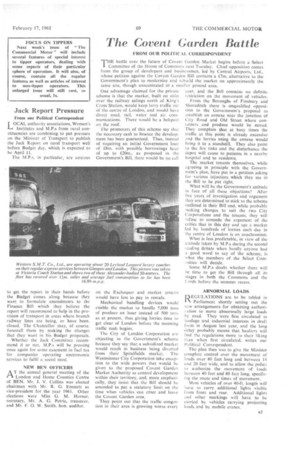The Covent Garden Battle
Page 39

If you've noticed an error in this article please click here to report it so we can fix it.
FROM OUR POLITICAL CORRESPONDENT
THE battle over the future of Covent Garden Market begins before a Select Committee of the House of Commons next Tuesday. Chief opposition comes from the group of developers and businessmen, led by Central Airports, Ltd., whose petition against the Covent Garden Bill contains a Om. alternative to the Government's plan to modernize and rebuild the market on approximately the same site, though concentrated id a smaller 'ground area.
One advantage claimed for the private scheme is that the market, built on stilts over the railway sidings north of King's Cross Station, wOulel keep lorry traffic out of the centre of London, and would hat c direct road, rail, water and air communications. There would be a heliport on the roof.
The promoters of this scheme say that the necessary cash to finance the development has been guaranteed. Thus, instead of requiring an initial Government loan of Om. with possible borrowings later of up to i20m.,. as proposed in the Government's Bill, there would be no call on the Exchequer and market tenants would have less to pay in rentals.
Mechanical handling devices would enable the market to handle 5,000 tons of produce an hour instead of 500 tons as at present, thus giving lorries time to get clear of London before the morning traffic rush begins.
The City of London Corporation arc objecting to the Government's scheme because they say that a subsidized market would result in business being diverted from their Spitalfields market. The Westminster City Corporation take exception to the wide powers that would be given to the proposed Covent Garden Market Authority to control development within their territory, and, more emphatically, they insist that the Bill should be amended to put a statutory limit on the time when vehicles can enter and leave the Covent Garden area.
They point out that the traffic congestion in their area is growing worse every
N ear, and the Bill contains no definite restriction on the movement of vehicles.
From the Boroughs of Finsbury. and Shoreditch there is unqualified opposition to the Government's proposal to establish an annexe near the junction of City Road and Old Street where conminers and produce would be stored. They complain that at busy times the traffic at this point is already excessive and the lorries using the annexe would bring it to a standstill. They also point to the fire risks and the disturbance the depot will cause to patients in a nearby hospital and to residents.
The market tenants themselves, while agreeing in principle with the Government's plan, have puit in a petition asking for various injustices which they see in the Bill to be put right.
What will be the Government's attitude in face of all these objections? After five years of investigation and argument they are determined to stick to the scheme outlined in their Bill and, while probably making changes to suit the two City Corporations and the tenants, they will refuse to concede the argument of the critics that in this day and age a market fed by hundreds of lorries each day in the centre of London is an anachronism.
What is less predictable, in view of the attitude taken by M.P.s during the second reading &bate when hardly anyone had a good word" to say of the scheme, is what the members of the Select Committee will decide.
Some M.P.s doubt whether there will be time to get the Bill through all its stages in both the Commons and the lords before the summer recess.
ABNORMAL LOADS
REGULATIONS are to be tabled in 1 • Parliament shortly setting out the new arrangements for obtaining authorie ttion to move abnormally large loads by road. They were firsi circulated to haulage and industrial interests in draft form in August last year, and the long delay probably means that hauliers will find the regulations more to their liking than when first circulated, writes our Political Correspondent.
The plan then was to give the Minister complete control over the movement of loads over 80 feet long and between 14 and 20 feet wide, and to allow the police io authorize the movement of loads between 40 feet and 80 feet long, specifying the route and times of movement.
Most vehicles of over 40-ft. length will have to carry additional lights visible from front and rear. Additional lights and other markings will have to be carried by vehicles carrying projecting loads and by mobile cranes.




















































































































